

 |
 |
||||
| Home | Reviews | Extras | Forums |
|
Flying WitchSynopsisModern witch Makoto Kowata moves into the Kuramoto household situated in Aomori. Since she's reached the age of 15, she's expected to make it on her own while continuing her witch training. While life in Aomori is generally quiet, Makoto and her witch associates bring their own brand of weirdness to life for herself and the people she meets. ReviewIf you think this show sounds a whole lot like Kiki's Delivery Service with a teenage protagonist, you're probably far from the only one. The concept is certainly similar on the ground level, but Flying Witch also seems to lean more towards "quiet town" trends that serves as the background for shows like Tamayura or Non Non Biyori while borrowing a sense of natural wonder found in Yokohama Shopping Trip Log as well as the endearing character traits and interactions of Yotsuba&! And the best part? Flying Witch more than lives up to any and all of these respected names within their respective genres. I had high hopes for this show, and Flying Witch managed to outdo every expectation I had. 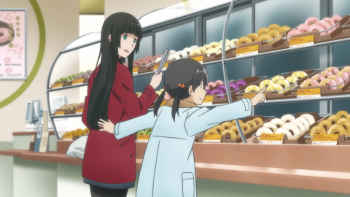 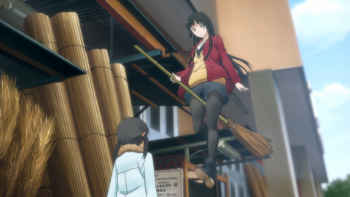 Aomori might be a little flat for my general tastes -- I'm more of a mountainous region guy; I mean... ask me why I fell so in love with Encouragement of Climb -- but its presented in an almost staggering amount of depth and a really detailed representation of the vast yet quiet city located in the Northern parts of Japan. All the buildings, all the bridges, paths, forests, fields and mountains are drawn in a way that's very true to life, and even the inside of each and every house or building they run into have a very personal feel to them, which makes me suspect that the animation crew went there for the sake of research. The vehicles are, conventionally, rendered in CG, which works well for the most part, with the occasional hiccup of a vehicle moving in a weird way. (The bus turning in the first episode being a very obvious example of this.) But some of the scenes from the air, like when one of the witches are flying on their broom, is to die for. Flying Witch is scenery porn heaven, and I couldn't possibly have been any happier about it. Even the characters look more like human beings than they tend to do in most shows -- much as I like Is the Order a Rabbit?, the girls there are moe arcetypes in design. Flying Witch's characters lean more towards the kind you'd see in Yotsuba&!; still drawn to resemble some sort of comic or animation, but more humanized than you'd usually see in the kind of shows that become popular. In many cases, it makes the characters look a bit older than they really are; Makoto and her friends look more like they're 17 or 18 instead of 15, and I even pegged Chinatsu to be more like 12 rather than her apparent age of 9. Granted, I'm a self-admitted terrible judge of people's age, so I'm even taking that with a grain of salt myself. Even better, all of the characters in this show come with a large selection of casual clothing that helps sell their personalities, as does Kei's bizarre taste in movies, with names like "Expiation in Ridel Prison" and "High Speed Soldier". (The latter looking like a pretty blatant Rambo II knockoff, at least by the cover art.) As in most of the slice-of-life shows I love so much, the characters in Flying Witch are all pretty nice people. Makoto herself is a bit of an airhead, but a good kind, much like a certain Akari Mizunashi. She seems a bit absent-minded at times, but part of that might be because of her status as a witch, which gives her a different perspective compared to human beings. A lot of the jokes based around her alleged airheadedness is the weird disconnect between witch and human, and why a witch might see it as a great gift to grant one a Mandrake, while a human being wouldn't even begin to understand how to deal with a giant root that moves as if it's alive and makes a lot of really creepy sounds. Makoto also has a lot of conversations with her cat -- isn't not that she just talks to it; the cat answers her in a way that sells it, even if all you hear from the cat itself is a lot of meowing. She forms an especially endering bond with Chinatsu, the young sister of the household, who, while sceptical to Makoto at first, really takes to her once she finds out that she's a witch and can do stuff like... fly with a broom or make magical concoctions. She can be a bit slow on the uptake at times, and in a weirdly ironic twist, she's also easily surprisable despite her status as a witch. In fact, it's Chinatsu's unbridled childishness that gives the show much of its sense of fun and liveliness. Her portrayal as a child is very true to life; full of energy and curiosity towards anything that's different and cool and an almost unabashed honesty, plus some pretty hilarious facial expressions whenever she's taken off guard. And while Makoto might arguably be Flying Witch's main character, Chinatsu is the one stealing the show the most often. In second place, the cats even do their share, even if they might need some human help to get their thoughts across. Makoto's cat familiar is a black male kitty named Chito -- or maybe it's a female; it is described in male pronouns at first, but episode 7 starts referring to Chito as a "granny" or "she", so... I have no idea -- and much like Sketchbook ~Full Color's~, Flying Witch is a show that really gets cats. Unlike in Sketchbook, Chito or fellow cat familiar Kenny doesn't ever speak in any human languages. They mostly let their thoughts and opinions be known through conversations with witches or, as one half of an episode let us see, their own brand of body language.  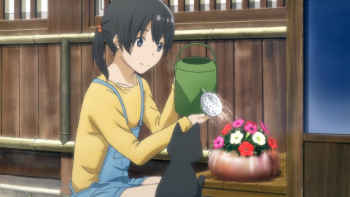  The remaining members that gets a lot of screentime are Chinatsu's big brother Kei, a relatively sensible young man who is sometimes told he'd make a great wife due to his domestic abilities, ribbing he takes in stride. There's Nao, one of the local ladies who are also Makoto and Kei's classmate. She's the recipient of Makoto's Mandrake gesture in the beginning of the show and is probably the one who's weirded out the most by Makoto's behavior. On the flip side, Chinatsu and Kei's mother, Nana, doesn't really seem to be bothered by anything, regardless of levels of weirdness. Makoto also has a big sister, Akane, who's travelling the world, but drops by from time to time. She's generally responsible enough, but tends to have a "bad drunk" side, something she shares with a friend of hers, Inukai, a fortune teller witch who, due to certain... circumstances, turns into a dog woman by day. And so we reach the main reason for my comparing this show to Kiki's Delivery Service; Flying Witch takes a rather low-key approach to the witching business. Instead of being big and flashy, most of the witch skills in this show might be visually unimpressive, but very practical. Makoto herself wants to study medicine, which involves herbology (hence her encounter with the Mandrake in the beginning of the show), while Akane's first visit culminates in a lesson of how to summon crows by putting black hair in an envelope, writing something and burning it in a small fire outside. It's fairly low key, but it gives the show a more realistic edge that works very well alongside the slice-of-life parts. There are more... immediately supernatural aspects to Flying Witch too, like something that happened to a friend of Akane named Inukai, and... well, I won't ruin that surprise for you. And, as you'd expect, Chinatsu's mother took it all in stride. In addition, we do get the occasional visits from other supernatural creatures, like the herald of spring or a postman who delivers papers for witches, both of which sports mostly humanoid shapes, much like the more humanoid yokai in Natsume's Book of Friends.   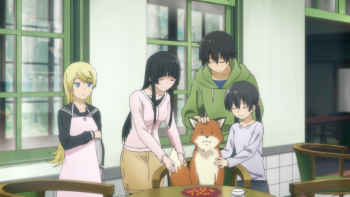 Furthermore, witch society in this series is on a sorta-secretive level. This means that some people are aware of witches on a familiar level, but witches in general don't really announce their presence or status, and in one scene, Makoto (mildly) freaks out when someone calls her out for being one. Still, it doesn't really seem like it's socially unacceptable to be one, and it's a wonder everyone hasn't figured it out, given that the girls apparently sees no problem in flying around on their brooms in broad daylight. A conversation between Makoto and Akane (with Chinatsu present) implies that witches used some of their abilities in wars, which is a... sort of positive angle, I guess? At least in the "witches are accepted, even if for pragmatic reasons" department. The witch hunts aren't really mentioned, probably because they'd be too dark a morsel for this show to swallow. It's this low key-edness that makes the more magical aspects of Flying Witch so wonderful. Akane's friend aside; Makoto, Chinatsu and Kei visits a cafe somewhere in the middle of the show that looks like an abandoned, dilapidated building in the middle of a forest, but go through a small ritual and it suddenly looks like a newly restored and fully furnished building, and a particularly cozy one at that... with a ghost waitress waiting to take your order inside. And even that isn't half as impressive as episode 11, when Makoto, Chinatsu and Akane visit a huge flying whale with a long abandoned city on its back. I had to slap myself in my face to remind myself to shut my mouth, and the best part is that the whole thing is such a perfect marriage between the natural and the magical. The show is never flashy, not even once. It doesn't need to. 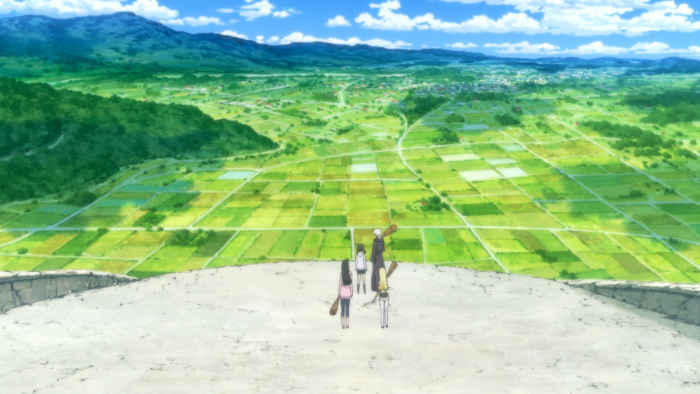 I've compared this show to many others during this review, but make no mistake about it: Flying Witch is a show all on its own. I would certainly not accuse it of stealing; most of the comparisons and reminders made in this review is more about the feelings they convey rather than any particular similarities between the shows themselves, and Flying Witch has so many of them. There is a sense of calm in this show, a "set your own pace" thing that doesn't imply you're unambitious or lazy for doing so, or that you'll lose track of your goal just because you're paying more attention to your surroundings than your average "work hard" protagonist. There is also a sense of being aware of your surroundings, both magical and otherwise, as well as the effects time has on some of those places that really sells this show and its many facets. I had an absolutely lovely time with this show, and I will be very sad if it doesn't get a physical release. An absolute wonder of a show that slice-of-life enthusiasts should not miss for any reason. — Stig Høgset Recommended Audience: There is no fanservice to speak of in this show, and the only violence is a few relatively mild seconds of Kei watching High Speed Soldier, where there is... AN EXPLOSION! AND SOMEONE FIRING GUNS TOWARDS THE TV! Version(s) Viewed: Digital stream on Crunchyroll, Japanese with English subs. Review Status: Full (12/12) Flying Witch © 2016 J.C. Staff. |
 |
|
| © 1996-2015 THEM Anime Reviews. All rights reserved. |